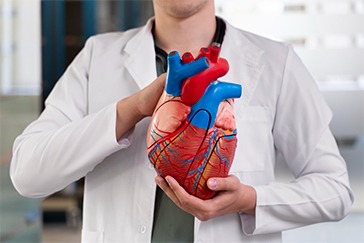 Book Appt.
Book Appt.
 Call Now
Call Now


The heart, an organ often associated with romantic emotions and metaphors, is undoubtedly one of the most vital organs in the human body. Its consistent and rhythmic beating is essential for maintaining life. However, when the heart's rhythm falters, a condition known as arrhythmia arises, disrupting the orchestration of this biological symphony. In this 600-word exploration, we delve into the complexities of arrhythmia, its types, causes, symptoms, and available treatments.
Arrhythmia, simply put, is an irregular heartbeat. In a healthy heart, electrical signals initiate each heartbeat, coordinating the synchronized contractions of the heart's four chambers – the two atria and two ventricles. These electrical impulses follow a precise pathway, ensuring that the heart pumps blood efficiently, delivering oxygen and nutrients to the body's organs and tissues. However, when something goes awry in this intricate electrical system, arrhythmia occurs.
Types
There are several types of arrhythmias, each characterized by distinct abnormalities in heart rhythm. The two broad categories are bradyarrhythmias and tachyarrhythmias. Bradycardia refers to a slower-than-normal heart rate, typically below 60 beats per minute. On the other hand, tachycardia indicates a faster-than-normal heart rate, usually exceeding 100 beats per minute.
One of the most common arrhythmias is atrial fibrillation (AFib), a type of tachyarrhythmia where the atria quiver instead of contracting properly. This chaotic atrial activity can lead to blood clots and increase the risk of stroke. Bradycardias, such as sinus bradycardia or heart block, result from a slowed electrical signal through the heart's natural pacemaker – the sinoatrial node (SA node). This causes a slower heart rate and can result in dizziness, fatigue, or even fainting.
Causes
Arrhythmias can be caused by a multitude of factors, ranging from structural heart defects, age-related changes, and coronary artery disease to lifestyle choices like excessive alcohol consumption, smoking, and drug abuse. Some medications and genetic predispositions can also contribute to arrhythmia development. Understanding the underlying cause of an arrhythmia is crucial for appropriate treatment and management.
Symptoms
The symptoms of arrhythmia can vary widely depending on the type and severity of the condition. Some individuals may not experience any symptoms at all, while others may report palpitations, dizziness, shortness of breath, chest pain, or even loss of consciousness. These symptoms may be transient or persistent and should never be ignored, as they may signal a more serious underlying heart condition.
Diagnosis
Diagnosing arrhythmia often involves a combination of medical history analysis, physical examination, and diagnostic tests. An electrocardiogram (ECG or EKG) is a common tool used to record the heart's electrical activity, helping identify the specific arrhythmia type and its origins. In some cases, a Holter monitor may be used for continuous monitoring over a 24 to 48-hour period, capturing any intermittent arrhythmias that may not show up on a standard ECG.
Treatment
Treatment options for arrhythmia aim to restore the heart's normal rhythm, control the heart rate, and reduce the risk of complications. In cases of bradyarrhythmia, a pacemaker may be implanted to regulate the heart's rhythm. This small device is placed under the skin and connected to the heart, emitting electrical impulses as needed to maintain a proper heart rate.
For tachyarrhythmias, medications may be prescribed to slow down the heart rate or convert the rhythm back to normal. In cases of severe tachyarrhythmias like ventricular fibrillation, immediate cardioversion may be required, involving the delivery of an electric shock to the heart to restore its normal rhythm. Ablation procedures, which use radiofrequency energy or cryotherapy, can also be employed to destroy abnormal heart tissue causing arrhythmias.
In some instances, lifestyle modifications play a crucial role in managing arrhythmia. These may include reducing stress, avoiding caffeine or alcohol, maintaining a healthy weight, and adopting a heart-healthy diet. Engaging in regular physical activity under the guidance of a healthcare professional can also improve heart health and reduce the risk of arrhythmia.
In conclusion, arrhythmia is a complex and potentially life-threatening condition that disrupts the heart's rhythm. It can manifest in various forms, with different causes and symptoms. Timely diagnosis and appropriate treatment are essential for managing arrhythmia and preventing complications. Understanding the importance of heart health, adopting a heart-healthy lifestyle, and seeking medical attention when needed are all key steps in maintaining the rhythm of life.
SHALBY Sanar International Hospitals provides extensive medical procedures backed up with our state-of-the-art technology and a team of highly qualified & experienced clinical experts.

Life-Changing TAVR Success Story | Dr. D.K. Jhamb | SHALBY Sanar International Hospitals

Timely Angiography Procedure Saves life of Iraqi Patient.

Rajiv Makhni, Managing Editor of NDTV, Shares His Experience at SHALBY Sanar International Hospitals

A successful treatment procedure helped Ms. Suri get over breathlessness
Our doctors pen down their research findings and experiences from time to time. Their words provide deep insight into the latest techniques, technologies and other advancements in healthcare. It provides expert answers to all kinds of health questions for real-life issues.
VIEW ALL




Since the day of its foundation, SHALBY Sanar International Hospitals is committed to provide comprehensive healthcare services. It regularly organizes awareness programs in its premises and encourages outdoor healthcare activities and camps with an intent to put focus on preventive healthcare.
VIEW ALL